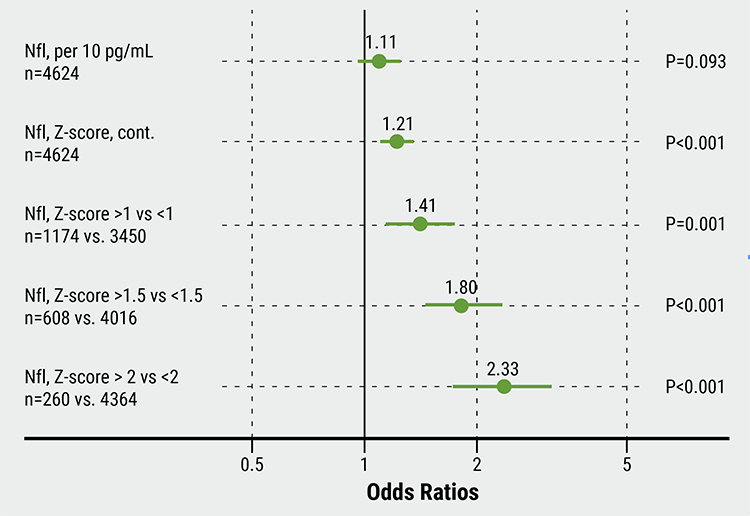Participants were 1,062 patients from the Swiss MS Cohort Study, of whom 95.9% had relapsing-remitting MS and 4.1% clinically isolated syndrome (CIS). Median age was 39.7 years, median EDSS 2.0, and median follow-up 5 years. All patients were on disease-modifying therapy for at least 3 months. sNfL was measured every 6 or 12 months with the NF-light® assay. A total of 5,192 longitudinal samples were analysed and compared with 8,865 samples of healthy controls.
Clinical events (EDSS worsening or relapse; n=4,624) in the following year were predicted by the sNfL z-score (OR 1.21; P<0.001). There was a “dose-effect relationship” with increasing sNfL z-score (see Figure). Results for the prediction of future new/enlarging T2 lesions and brain volume loss were similar. In a multivariable mixed logistic regression model, new/enlarging T2 lesions (OR 1.88; P=0.016) and sNfL z-score >1.5 (OR 2.18; P=0.009) predicted future clinical events (n=853); previous EDSS worsening, previous relapses and current contrast enhancement did not. Even in NEDA-3 patients, change of sNfL z-score could predict clinical events (relapses, EDSS worsening, contrast enhancing or new/enlarging T2 lesions in brain MRI; n=587) in the subsequent year (OR 1.37; P=0.025).
Figure: sNfL z-score predicts relapse or EDSS-worsening in the following year [1]

These study results in a well-characterised, large, real-world cohort support the use of sNfL to monitor treatment effects in MS clinical practice. According to the authors, sNfL gives a unique signal that is not captured by other markers.
- Yaldizli Ö, et al. Value of serum neurofilament light chain levels as a biomarker of suboptimal treatment response in MS clinical practice. MSVirtual 2020, Abstract PS09.05.
Posted on
Previous Article
« Interrupting DMT due to pregnancy increases NfL levels Next Article
Predictive value of CSF Aβ and tau proteins in MS »
« Interrupting DMT due to pregnancy increases NfL levels Next Article
Predictive value of CSF Aβ and tau proteins in MS »
Table of Contents: MS Virtual 2020
Featured articles
COVID-19 and MS
Biomarkers
Treatment Strategies and Results
Management of progressive MS with approved DMT
Novel Treatment Directions
Neuromyelitis Optica Spectrum Disorders
Miscellaneous Topics
Related Articles
December 9, 2021
Dynamic scoring system aids decision to switch MS therapies early
September 10, 2020
High NEDA rates after 2 years of ocrelizumab
© 2024 Medicom Medical Publishers. All rights reserved. Terms and Conditions | Privacy Policy
HEAD OFFICE
Laarderhoogtweg 25
1101 EB Amsterdam
The Netherlands
T: +31 85 4012 560
E: publishers@medicom-publishers.com

